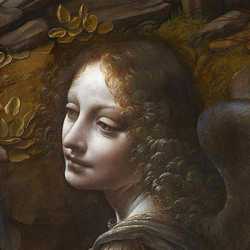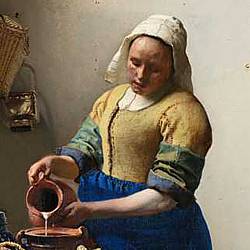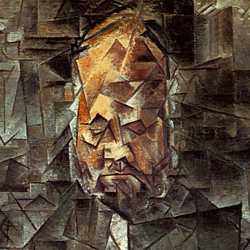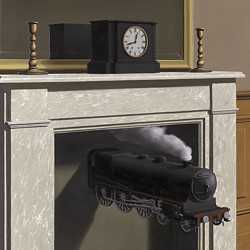Modern Art Timeline Part 2 - Dada and Surrealism to Minimalism
Our Modern Art Timeline from 1916-1975 gives an outline of the most important artists, movements and styles of painting from Dada and Surrealism to Minimalism.
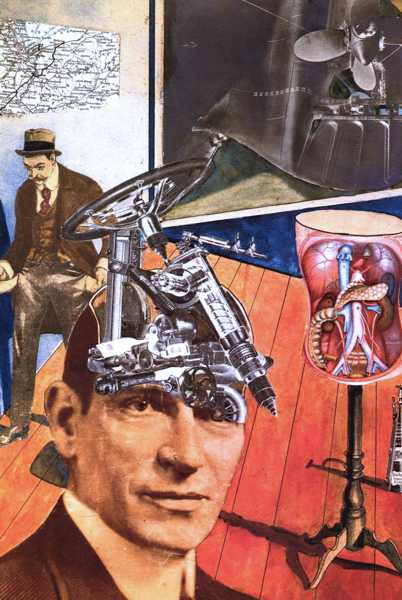
RAOUL HAUSMANN (1886-1971)
'Tatlin at Home', 1920
(collage)
Dada or Dadaism was not a style of art like Fauvism or Cubism. It was a form of artistic anarchy born out of disgust for the social, political and cultural establishment of the time which it held responsible for Europe's descent into World War.
Dadaism was an ‘anti art’ stance as it was intent on destroying the artistic values of the past. The aim of Dada was to create a climate in which art was alive to the moment and not paralysed by the corrupted traditions of the established order. Dada’s weapons in the war against the art establishment were confrontation and provocation. They confronted the artistic establishment with the irrationality of their collages and assemblages and provoked conservative complacency with outrageous actions at their exhibitions and meetings.
The Dada movement started in Zurich and spread as far as New York. Max Ernst, Marcel Duchamp, Raoul Hausmann, Jean Arp and Kurt Schwitters were among the best of the Dada artists.

RENÉ MAGRITTE (1898-1967)
'Time Transfixed', 1938
(oil on canvas)
Surrealism was the positive response to Dada's negativity. The aim of Surrealism, as outlined in the First Surrealist Manifesto of 1924, was to liberate the artist's imagination by tapping into the unconscious mind to discover a 'superior' reality - a 'sur-reality'. To achieve this the Surrealists drew upon the images of dreams, the effects of combining disassociated images, and the technique of 'pure psychic automatism', a spontaneous form of drawing without the conscious control of the mind.
The look of Surrealist art was inspired by the irrational juxtaposition of images in Dada collages, the metaphysical art of Giorgio de Chirico, and both 'primitive' and 'outsider' art.
The most influential of the Surrealist artists were Max Ernst, Joan Miró, Salvador Dali and René Magritte. The movement broke up at the outbreak of war in 1939 when several of the Surrealists left Europe for New York where they had a formative influence on the development of Abstract Expressionism.

JACKSON POLLOCK (1912-1956)
'Full Fathom Five', 1947
(oil with nails, coins, buttons, cigarette etc. on canvas)
Abstract Expressionism was the first American art style to exert an influence on a global scale. It drew upon the ‘spiritual’ approach of Kandinsky, the 'automatism' of the Surrealists, and a range of dramatic painting techniques.
Abstract Expressionism was also known as ‘Action Painting’, a title which implied that the physical act of painting was as important as the result itself.
The Abstract Expressionist movement embraced paintings from a wide range of artists whose work was not always purely abstract or truly expressionistic. The ‘all-over’ drip paintings of Jackson Pollock, which entangle the viewer in a skein of light, color and texture, were the biggest challenge to the interpretation of pictorial space since Cubism. The paintings of Mark Rothko bathe the spectator in a mystical world of diffuse color while the art of Robert Motherwell sets up an abstract dialogue between his 'automatic' calligraphy and the conscious control of shapes and colors. Willem de Kooning, Franz Kline, Barnet Newman and Clifford Still were other major figures associated with the movement.

ANDY WARHOL (1928-1987
)
'Campbell's Soup 1 (Tomato)', 1968
(silkscreen on canvas)
Pop Art was the art movement that characterized a sense of optimism during the post war consumer boom of the 1950's and 60's. It coincided with the globalization of pop music and youth culture, personified by Elvis and The Beatles.
Pop Art was brash, colorful, young, fun and hostile to the artistic establishment. It included different styles of painting and sculpture from various countries, but what they all had in common was an interest in popular culture.
The stark look of Pop Art emerged from a fusion of Dada collages and 'readymades' with the imagery of the consumer culture. It was seen as an antidote to the introspection of Abstract Expressionism. The expressive techniques of Jasper Johns and Robert Rauschenberg provided the stylistic link between Abstract Expressionism and Pop but the images of celebrity and consumerism by Andy Warhol and the comic book iconography of Roy Lichtenstein represent the style as we know it today.

BRIDGET RILEY (b.1931)
'Blaze', 1962
(emulsion on hardboard)
Op Art is short for 'optical art'. It was an abstract style that emerged in the 1960's based on the illusionistic effects of line, shape, pattern and color.
Op Artists such as Victor Vasarely, Bridget Riley and Richard Anuszkiewicz play with the perception of the viewer by subverting the picture plane with ambiguous shapes, shifting tones and dynamic color relationships. Although Op Art images are static they generate the illusion of movement with perceptual tricks that create an unstable picture surface. The effects of this can be so strong that you have to look away for fear of losing your balance or hurting your eyes. Needless to say that the fairground fun aspect of Op Art was very popular with the public and was quickly commercialized by the design and fashion industries.

FRANK STELLA (b.1936)
'Brzozdowce I', 1973
(relief assemblage)
Minimalism was not only a reaction against the emotionally charged techniques of Abstract Expressionism but also a further refinement of pure abstraction. It was an attempt to discover the essence of art by reducing the elements of a work to the basic considerations of shape, surface and materials.
Minimalist art used hard-edged forms and geometric grid structures. Color was simply used to define space or surface. Ad Reinhardt, whose late paintings anticipate Minimalism, put it simply, ‘The more stuff in it, the busier the work of art, the worse it is. More is less. Less is more. The eye is a menace to clear sight. The laying bare of oneself is obscene. Art begins with the getting rid of nature.’
Frank Stella, Don Judd, Robert Morris, John McCracken and Sol LeWitt were important contributors to Minimalism.

